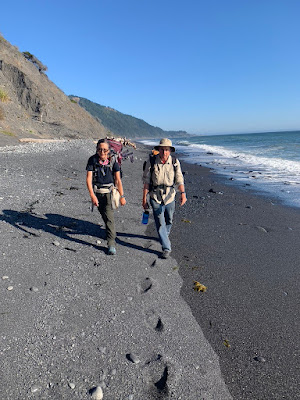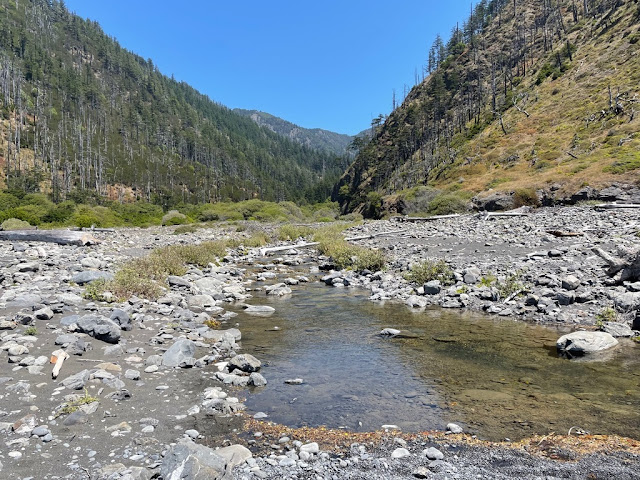 |
| a short inland section on day 3 |
The King Range Wilderness area in Northern California (aka Lost Coast) is one of the rare areas for a beach hike in a wilderness area. It is a National Conservation Area, administered by the Bureau of Land Management, and less developed than a National Park. But it also has a low quota of backcountry permits. Usually those are gone months in advance, but I got a 3-person permit for the week after July 4th. Kathy invited our friend John Zaller, who immediately accepted even though he would come off a multi-day hike in the Sierras the day before we start.
The King Range is a steep coastal mountain range, so rough that no road was built on the beach side (unlike Big Sur). King Peak is 1300 m and within 5 km of the beach. However, the hiking route is along the water and almost entirely on sand and rocks. Elevation gain is minimal and the brief sections that go a little bit inland are very welcome for having a harder surface:
 |
| afternoon day 2 |
There are several sections that are only passable during low tide; other times, the waves crash against the rocks, often steep cliffs that offer no option for a detour. Our permit started during a full moon, which tends to have extreme tides. In this case, only an early morning low tide was low enough to get past otherwise impassable sections. That timing was perfect for us going opposite (south to north) to the typical route and it avoided congested campsites (as the N-S hikers had to aim for campsites just north of the impassable sections). Sometimes there will be no passable tide during the day.
We started after 4pm in the afternoon at Black Sands Beach (Shelter Cove), with pleasant air temperatures, but still a hot sun. We only had about 6km before the first section that requires a low tide and stopped at Gitchell Creek to camp.
 |
| Kathy and John along Black Sands Beach. |
The weather during all 3 days was clear with a gentle breeze (other times could be foggy with a strong headwind going north). Slept outside with just a tiny bit of moisture on the sleeping bag, there was no need for a tent or tarp.
Soft sand/gravel (even at low tide few spots with hard sand) and rocks make for a strenuous hike. Although our afternoon was just a small hike, the soft sand made it harder than one would think.
 |
| Early morning on day 2 |
But we weren't the first: There were already new animal prints in the sand. The mountains are steep, often cliffs, and even bears hike on the beach to get from one area to another (these fresh bear footprints can't be more than a hour old). Deer, too.
 |
| Fresh bear tracks |
It didn't take long before the animal tracks were obliterated by humans, within the next 2 hours, we saw several groups coming the opposite direction. The sand comes and goes, depending on how the coast line curves. At some places, deep sand gets deposited; elsewhere it gets washed away, leaving just medium to large rocks and little space between the water and the cliffs. This picture is during a very low tide, most low tides leave less space - and during higher tides, the waves crash against the rock.
 |
| These rocky sections are slow and strenuous |
The morning was great, but this was the longest day of the trip(about 20 km) and the afternoon sun is not as pleasant as the morning. The terrain (soft sand or rocks) makes walking harder than 20km sounds. The hiking experience is quite different from the mountains not just in scenery, but apparently walking mechanism: I got blisters on my toes despite wearing my usual hiking boots and socks.
We made camp at Randall Creek by 3.30, right before the next section that required waiting for a low tide.
Day 3 started off with a similarly lovely morning as the previous day, it just had a bit more fog and wind towards the end. The first section that has to be hiked during low tide had some spectacular rock formations, almost like a minuscule version of Devil's Postpile near Mammoth.
 |
| This needs a low tide - at other times, waves crash against the rocks |
Cooskie Creek is in the middle of that section and probably getting quite crowded at times (for people hiking N-S, the two camping options just before or along the impassable section are Sea Lion Gulch - where we saw the first people already making camp by 11am to start the next morning- or Cooskie).
 |
| Cooskie creek |
The narrow section ends at Sea Lion Gulch, which unsurprisingly has many sea lions sitting on the rocks. The trail goes inland for a little bit, but soon returns to the beach and then it is mostly deep sand until the trailhead at Mattole Beach. The last hour is definitely a sand slog.
Just before the final sand slog, the elephant seals at the old lighthouse provide some entertainment. Not a particularly exciting entertainment, mostly they lie next to each other and doze. The more enterprising ones use their flippers to toss sand on their backs every few minutes. They spend most of their time in the ocean and much further north (Alaska), but come to California twice a year. This is the summer beach vacation for molting (they will be back for the winter breeding season). But first they will be swimming north again. These are two very long round-trips each year!
Occasionally they get on each others nerves - maybe one was snoring too loudly? - raise up their fronts and yell and snort at each other for a minute. They are huge animals, the males weigh several tons, and the males are also astonishingly ugly to human eyes with their fat wobbly noses. Their females must perceive that wobble nose differently: They didn't become extinct despite being aggressively hunted by humans. I think that huge nose is only good for loud snoring or roaring sounds (unlike an elephant's trunk, they can't do anything practical with it). Those two guys roared for a minute, the outcome was that the one at the left moved maybe a foot back before they laid down again. The rest of the pack didn't move a flipper and didn't pay attention, except for the tiny one in the front who was unnerved by the racket.
 |
| Elephant seals snoozing and grumpy males yelling at each other near the lighthouse |
 |
| done, time to lie down again, the one with the bigger nose wins and gains a foot more space. |



No comments:
Post a Comment
Note: Only a member of this blog may post a comment.